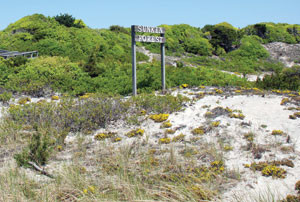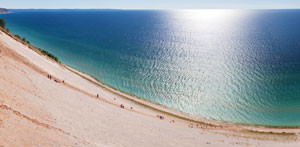
America’s 10 Best Beaches
I’m on my hands and knees scouring the beach for diamonds. It’s a picture-perfect summer day: sunny and warm, with practically no humidity and maybe the biggest blue sky I’ve ever seen. The beach is heavenly, with that sugar sand you find in the tropics, framed by a dune forest protecting the scrub-shrub habitats of nesting songbirds.
Diamonds — well, actually, beautiful, translucent pieces of quartz — are abundant, but that’s only a small part of the draw. There’s the privacy (it’s one of the region’s most sparsely populated beaches); the splendid bird watching (rated by Audubon as one of the best birding sites in the nation), and that special sand. Who knew that this slice of paradise — Higbee Beach in Cape May, New Jersey — is within a five-hour drive of one-third of the U.S. population?
The plain truth is the United States is a treasure trove of these magnificent hideaways. Following are some of the best in the country, selected with a bias toward geological uniqueness, magic, and unspoiled beauty. All you need bring is a towel and a picnic.
1. Pauoa Beach
Where: Waimea, Hawaii
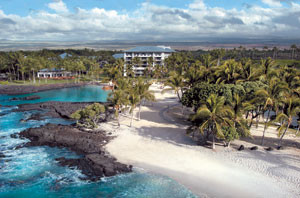
The white stuff. Sugary, ground-quartz sand of Henderson Beach washes down from the Appalachian Mountains and into the gulf.
Picture perfect! Pauoa Beach’s soft, pearl-white sand is flecked with coral, shells, and lava.
Wow factor: Ever dream of bathing in champagne? The beach fronts a postcard-worthy coral reef cove, where cooling freshwater springs bubble up from the bottom of the warm Pacific Ocean, making you feel like you are swimming in a bathtub filled with Fizzies. Later, while lounging on the warm sand, dig your feet down deep and feel the freshwater spritzing up.
Sand: The expanse of soft, pearl-white granules is flecked with colorful bits of coral, shells, and lava.
What to collect: Souvenir photos. Removing the lava that has bubbled up along the beach is illegal; worse, doing so is cursed by Pele, the Hawaiian goddess of fire.
Local lore: A five-minute walk from the beach is the Puako Petroglyph Archaeological Preserve with over 3,000 engravings. Archaeologists believe these petroglyphs depict life events of the local culture thousands of years ago.
When to go: Anytime. Daytime temperatures hover in the 70s and 80s year-round.
Stay: The beach resides on the grounds of the Fairmont Orchid (fairmont.com/orchid), which offers rooms with ocean views and private lanais.
Eat: Innovative farm-to-fork Pacific Rim fare is almost beside the point compared to a sunset show at Napua Restaurant (napuarestaurant.com); dinnertime guests get to watch stars light up the Kohala coastline after seeing the sun melt into the Pacific Ocean.
2. Bandon Beach
Where: Bandon, Oregon
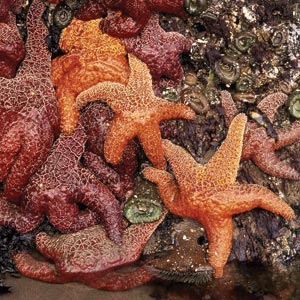
Star power Thanks to the chilly water. Bandon Beach is not a swimming beach. But there’s lot to explore, particularly at low tide.
Wow factor: Sandwiched between dense forest and the Pacific, the beach offers dramatic views of rock pillars (known as sea stacks) jutting from the ocean, as well as small islands inhabited by nesting seabirds, birthing seals, and more. Don’t be surprised if you happen upon a sea lion having a splash.
Sand: Fine heather-toned grains pack well for castle building.
What to collect: Agates. At least 20 varieties including carnelian, moss, and cloud.
Local lore: According to legend, the curious rock formations along the beach were formed when a mountain chief brought his daughter to the shore for the first time. Ignoring the warning that looking at the evil ocean spirit Seatco would turn her to stone, the daughter wandered the beach and was frozen in place.
When to go: Year-round. Frigid water and wind prohibit this from being a swimming beach; come dressed in layers as storms can kick up unexpectedly.
Stay: Every room and private cottage at Windermere on the Beach (windermereonthebeach.com) have beach access and panoramic views of the Southern Oregon coastline.
Eat: Bandon’s best scene for a sunset cocktail is The Loft (theloftofbandon.com), which sits atop the High Dock building and serves exquisite Pacific Coast-fusion cuisine.
3. Pfeiffer Beach
Where: Big Sur, California
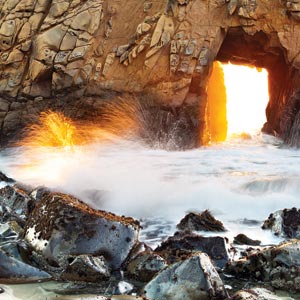
Hole lotta something! For natural drama, few things top the spectacle of waves crashing through Keyhole Rock.
Wow factor: Front and center in the crashing surf is Keyhole Rock, a gargantuan arch with waves hurtling through the center split. In winter, catch it just before dusk and see the setting sun cast its final rays through the keyhole.
Sand: The purple sand, located at the north end of the beach, draws its unusual color from manganese garnet fragments, eroded from deposits in the hills, that become finely ground as they wash onto the beach from the creek above.
What to Collect: Well, the sand, for starters. Diligent beachcombers can often find sizable chunks of manganese garnet that has been washed from the cliffs above onto the beach. But note: Digging into the rock face is prohibited.
When To Go: Wind gusts are common here year-round, but less harsh during the drier months, June–October.
Local lore: Big Sur’s dramatic landscape has been the setting for countless feature films, including according to Hollywood legend the famous kiss between Burt Lancaster and Deborah Kerr in From Here to Eternity.
Stay: For comfort and panoramic views, you can’t go wrong with Post Ranch Inn (postranchinn.com). The more adventurous will stay in the treehouse lodgings stilted nine-feet above the forest floor, where there’s still plenty of luxe with spa baths, fireplaces, and wood decks facing the forest.
Eat: Cliff-dwelling eatery Nepenthe (nepenthebigsur.com) was once a cabin owned by Orson Wells and Rita Hayworth. Now it’s the ideal spot for mojitos at sunset.
4. Cape Hatteras Lighthouse Beach
Where: Buxton, North Carolina
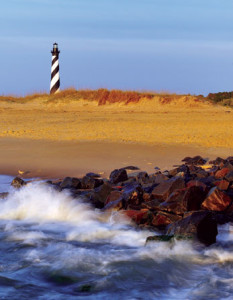
Point of view Cape Hatteras Lighthouse Beach in North Carolina is known for fine sand, turbulent seas, and shells galore.
Wow factor: The beach is part of a narrow barrier island jutting 30 miles into the Atlantic, so its landmass is forever changing. What’s most striking, however, is the “magic fairy dust” that gets kicked up with each shuffling step in the sand. At night, you’ll find yourself surrounded by a spellbinding blue-green sparkle caused by microscopic phytoplankton that glow when disturbed.
Sand: The cape is a convergence of two major ocean currents, the cold Labrador Current from the north and the warm Gulf Stream, which grind bivalve shells into fine, soft particles.
What To Collect: Shells galore — knobbed whelks, Scotch bonnets, augers, baby’s ears, and more.
Local lore: The Grey Man of Hatteras is a shadowy ghost who walks the beaches. As the story goes, he’s the spirit of a sailor who perished at sea.
When To go: Beach weather here spans spring, summer, and fall, thanks to the Gulf Stream that blows warm breezes in chillier months. Locals especially love autumn, with its lazy Indian summer afternoons, but the threat of hurricanes lurks through September.
Stay: The waterfront Inn on Pamlico Sound (innonpamlicosound.com) is a boutique hotel with island-style guest rooms, an oceanfront swimming pool, complimentary kayaks, and a gourmet restaurant.
Eat: Come to Dinky’s (villagemarinahatteras.com/DinkysGenInfo.html) for the local catch, and you’ll be treated to the best show on the island — sunset.
5. The Beach at Sunken Forest
Where: Fire Island, New York
Wow factor: Just over the dunes behind this uninhabited beach on the famous barrier island between Great South Bay and the Atlantic Ocean is a rare maritime forest of stunted plant clusters, visible from a boardwalk. This stunted, or “sunken,” effect is caused by saline mists from the ocean.
Sand: The soft, reddish sand is made up of fine white quartz, laced with minute red garnet and black flecks of magnetite.
What to Collect: Sand. If you want to amuse your kids, take a magnet to it and show them how the particles magically float up.
Local lore: Historians and locals have debated the origin of the name Fire Island for decades. Many believe that it was a misspelled translation of Five Barrier Islands from a 17th-century Dutch map. (The number of inlets changes periodically with the weather.)
When To Go: Late spring to early fall is when the beach is warm and the forest in bloom. The ferry from Sayville, Long Island, to Sailors Haven runs only mid-May–mid-October.
Stay: No hotels in Sunken Forest. But a few miles (and short water taxi ride) down the island is the chic Palms Hotel in Ocean Beach (palmshotelfireisland.com).
Eat: If you stay in Ocean Beach, try Maguire’s Bayfront Restaurant (maguiresbayfrontrestaurant.com), as much for the spectacular sunset views as for the cuisine.
6. Peterson Beach
Where: Sleeping Bear Dunes National Lakeshore, Michigan
Wow factor: Once named “the most beautiful place in America” by Good Morning America, Peterson Beach fronts Lake Michigan’s crystal blue Platte Bay. From the shoreline are unobstructed views of Sleeping Bear Point and Empire Bluff’s billowy sand dunes, formed during the last ice age. Some dunes soar as high as 450 feet.
Sand: While most of the Great Lakes have rocky shorelines, this beach is known for its powdery, golden sand.
What To Collect: You’ll find plentiful samples of Michigan’s state stone, the mottled Petoskey stone (fossilized rugose coral). Take pictures; the National Park Service doesn’t allow removing natural elements from the park without a permit.
Local lore: The Native American-inspired Legend of Sleeping Bear holds that a mother bear and her two cubs were driven into Lake Michigan by a forest fire. After swimming for hours, mother bear reached the shore first and perched on a bluff to await the cubs, but they soon tired and drowned. The Great Spirit Manitou created two islands to mark the spot where the cubs disappeared and a solitary bluff representing the mother bear.
When To Go: While each season brings distinctive hues and vistas, summertime offers the most tolerable water temps (up to mid-60s) for swimming.
Stay: The lakefront Homestead (thehomesteadresort.com) offers a range of resort activities and lodging options.
Eat: Blu (glenarborblu.com), with panoramic views of Sleeping Bear Bay, incorporates local provisions into its eclectic menu.
7. Padre Island National Seashore
Where: North Padre Island, Texas
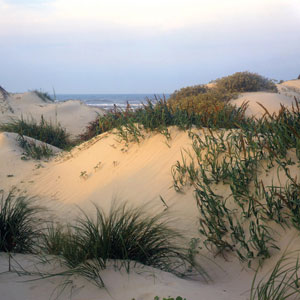
Untamed. Beaches at North Padre Island are desolate, populated by rare, protected wildlife including 380 species of birds.
Wow factor: The longest undeveloped barrier island in the world stretches 113 miles between the Gulf of Mexico and Laguna Madre, one of the world’s few hypersaline coastal lagoons. Unlike kitschy and crowded South Padre Island, no hotels or businesses clutter the untainted seashore bordered by a narrow dune ridge, coastal prairie, and tidal flats. The beaches are quite desolate, populated by rare, protected wildlife, including endangered turtles and some 380 species of birds. The highway ends 10 miles in, so adventurers in four-wheel-drive vehicles must cross the sand from one beach to the next.
Sand: Billowy white sand, laden with exquisite shells.
What To Collect: Shells — common arks, cockles, and quahogs — and colorful coquina mostly found on Big and Little Shell beaches. Park Service permits the removal of up to five gallons of shells per day.
Local lore: Padre Island is reported to be a prime hiding spot for pirate gold. (Too bad the National Park Service prohibits the use of metal detectors.)
When To Go: As one of the southern-most spots on the mainland U.S., even December can bring warm days. Considering the staggering heat and humidity of summertime and hurricane threat into the fall, locals prefer the months of February–April when precipitation is low and temperatures often hover around 70 degrees.
Stay: The modern oceanfront Sandpiper Condominium (sandpiperportaransas.com) is a welcome respite after a day of trekking around Padre’s primitive shoreline. The resort offers well-stocked units with kitchens and balconies, a pool, and beach loungers.
Eat: Snoopy’s Pier (snoopyspier.com) is a family-owned, beachfront eatery serving local catch prepared with family recipes.
8. Higbee Beach
Where: Cape May, New Jersey
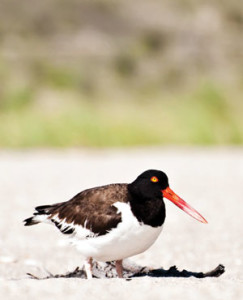
Hunt and peck. An American oystercatcher searches for a snack in the sugar sand of beautiful Higbee beach.
Wow factor: Cape May’s sugar-sand beaches are considered among the cleanest in the nation, sparkling clean, in fact. Some of that sparkle comes from sand laced with Cape May Diamonds — gorgeous, translucent quartz. The stones wash up on Higbee Beach from the upper reaches of the Delaware River. Higbee, at the tip of Cape Island, also contains the area’s only remnants of coastal forest, protected by dunes up to 35 feet high.
Sand: The shoreline is blanketed with that downy white-blond sand normally associated with Caribbean beaches.
What To Collect: Those diamonds, of course. The largest wash ashore during winter months, when the current is strongest.
Local lore: Kechemeche tribe believed the diamonds possess supernatural powers.
When To Go: May–mid-October.
Stay: Congress Hall (caperesorts.com/hotels/capemay/congresshall) is a sprawling, historic beach resort still operating in grand style.
Eat: The Washington Inn (washingtoninn.com), in a restored 1840s plantation house, features a menu of continental fare that changes daily to incorporate the local harvest.
9. Moshup Beach
Where: Martha’s Vineyard, Massachusetts
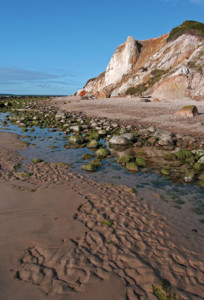
Rock steady. Russet-colored clay cliffs encase eons of ancient animal and marine fossils on Moshup Beach in a protected corner of Martha’s Vineyard.
Wow factor: Moshup (aka Gay Head or Aquinnah) is one of the few places on the East Coast where you can catch the sunset — rather than sunrise — from a sandy beach. This secluded shoreline of white sand and crystal-clear water is sometimes tinged red by the surrounding russet-colored clay Aquinnah Cliffs, encasing eons of ancient animal and marine fossils — whales, horses, even camels — in their auburn grooves. Smattered around the beach are age-old rocks worn smooth by the crashing tide, and pieces of lignite — scientists say from the Cretaceous period. The most scenic time is sunset, when the cliffs glow with terracotta hues.
Sand: Surrounded by multi-hued rocks and clay cliffs, the soft, white sand takes on a variety of shades throughout the day.
What To Collect: The brightly striated glacial rocks, fossils, and mud (with legendary healing powers) are protected property, so capture them with your camera only.
Local lore: Native Wampanoag tribal folklore attributes the unique geology to a giant named Moshup. He hunted whales and threw them against the cliffs; their blood turned the clay red and their remains are those fossils found today.
When To Go: Most visitors and businesses operate around the seasonal ferry schedules, which run from Woods Hole or Falmouth with regular service mid-May–mid-October.
Stay: The cozy guest rooms of the cliff-dwelling Outermost Inn (outermostinn.com), owned by musician James Taylor’s brother Hugh, provide spectacular three-way vistas spanning the Nantucket Sound.
Eat: In a rural garden overlooking the ocean, Beach Plum Inn (beachpluminn.com) incorporates local provisions into imaginative dishes.
10. Henderson Beach State Park
Where: Destin, Florida
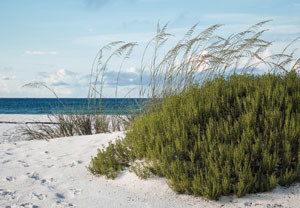
The white stuff. Sugary, ground-quartz sand of Henderson Beach washes down from the Appalachian Mountains and into the gulf.
Wow factor: The beach here is known for its whitest-of-white, sugary sand. Plus, great fishing.
Sand: The ground-quartz sand washes down from the Appalachian Mountains via the Apalachicola River out into the Gulf of Mexico. From there, the sand drifts west in the currents, much of it settling here.
What To Collect: Dune rosemary, an edible, non-endangered Florida scrub, that sprouts fragrant lavender flowers in springtime.
Local lore: Destin calls itself the World’s Luckiest Fishing Village. Perhaps that’s because the continental shelf comes closer to shore in Destin than anywhere else in the state, allowing anglers to reach every depth of fishable waters more easily.
When To Go: April–May and September–November are when ocean temperatures range a comfortable 60–80 degrees.
Stay: Henderson Park Inn (hendersonparkinn.com), Destin’s only B&B on the beach offers romantic guest rooms overlooking the beach, gourmet breakfasts, box lunches, beach chairs, umbrellas, and bicycles.
Eat: For Gulf-shore gastronomy, accented with a Creole flair Louisiana Lagniappe (thelouisianalagniappe.com/destin) is a longtime local favorite. Hush puppies, jambalaya, blackened shrimp etouffee, it’s all here.
Copyright © 2015, The Saturday Evening Post
Copyright @ 2015, The Saturday Event Post

